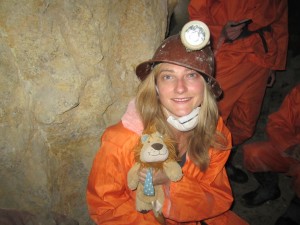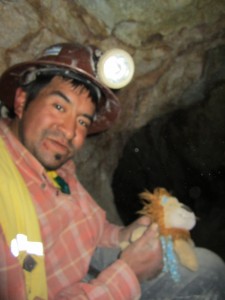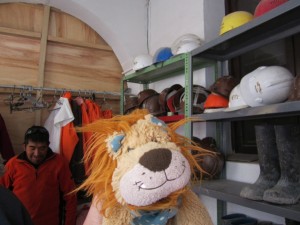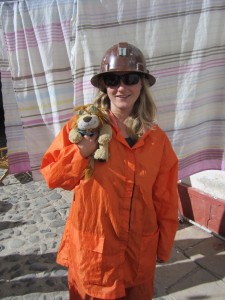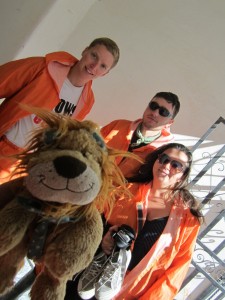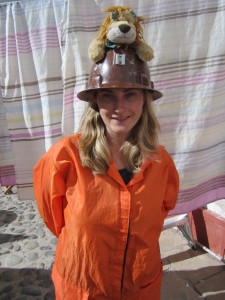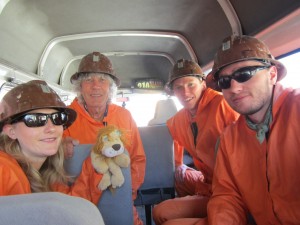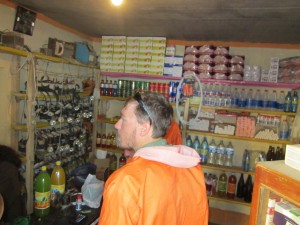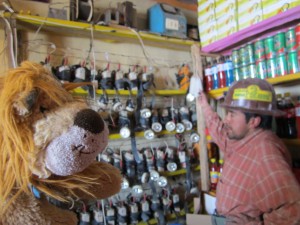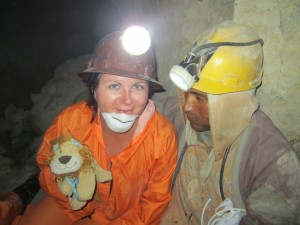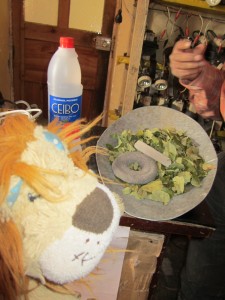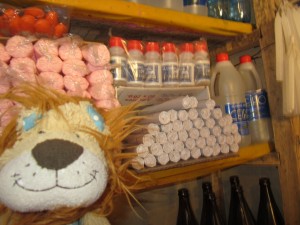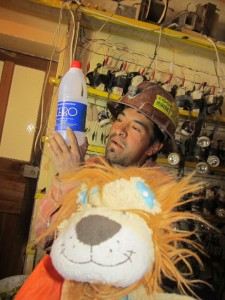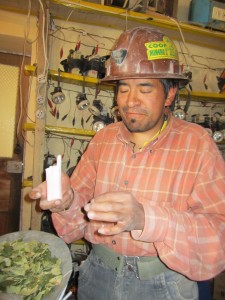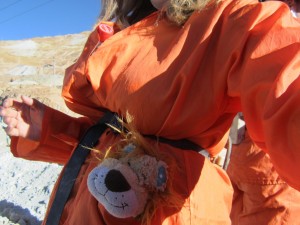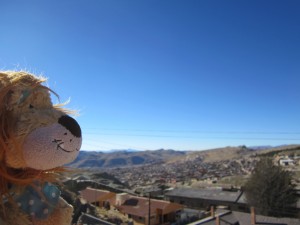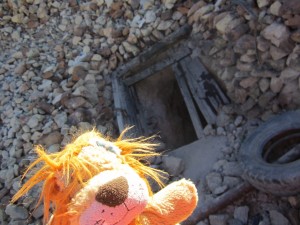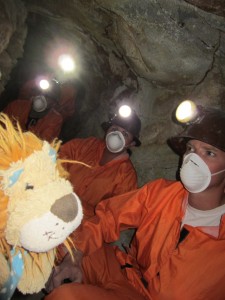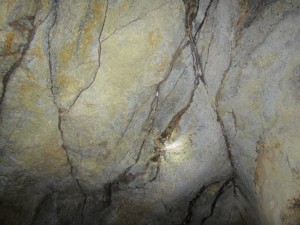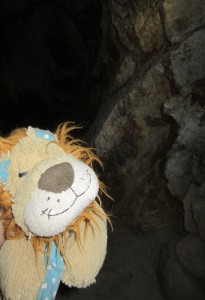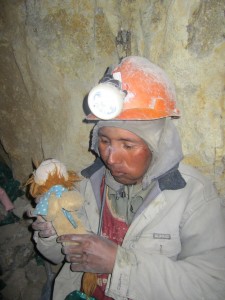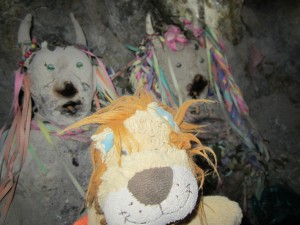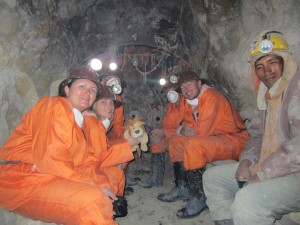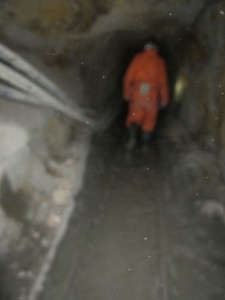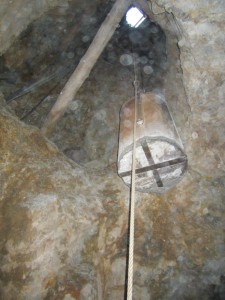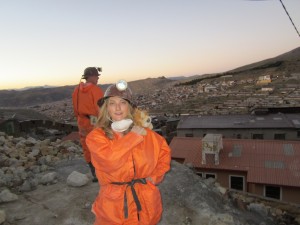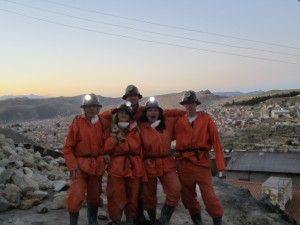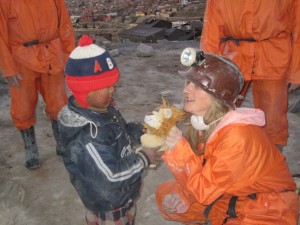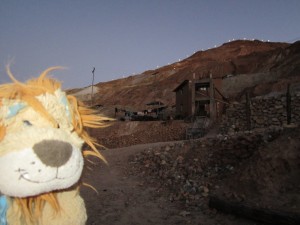As Lewis discovered that Potosí was a city famous for mining, it only seemed right and proper that he should take a visit to one of the mines. Luckily for him, in his hostel there was his very own guide, Antonio, who had previously worked down the mines for the co-operative 1 de Abril.
Antonio’s father and grandfather had also worked in the Cerro Cinque which formed part of the Cerro Rico mountainside. It was perhaps one of the highest mines in the world at 4,000 metres. Once upon a time, silver was the main metal sourced from the mine which brought riches to the town of Potosí. However, today the main minerals mined are tin, lead and zinc, along with small amounts of silver.
Before Lewis the Lion visited the mine, Helen and her friends needed to wear the right equipment: bright orange waterproofs, wellington boots (with a plastic bag liner in each) and a helmet to which a lamp would be fitted.
They also had to visit a specialist mining shop to buy some gifts for the miners.
This is because miners today are very poorly paid at this particular mine in Bolivia and because it is a working mine, they willingly accept gifts from any visitors. An unexperienced miner, pushing wheelbarrows and shovelling rocks into the carts earns $50 Bolivianos a day. A miner’s assistant can expect to earn up to $80 Bolivianos a day and an experienced miner with 15 years of experience who drills holes can earn $150 Bolivianos a day. However, this wage may vary depending on the quality of the minerals mined. (The minerals mined are used for things such as batteries). Nonetheless, compared with Western wages, this was quite a shocking revalation for Lewis the Lion, especially for such a dangerous job.
Furthermore, Lewis the Lion discovered that in Bolivia, children could start working down the mine at the age of 14. Rather disturbingly, Lewis also discovered that the average life-expectancy is between 30 and 40 years old. This is mainly due to the working conditions as the mines are filled with a deadly powder called asbestos. Miners therefore often die young of lung diseases like silicosis and emphycaemia. Because of the high mortality rate, mining families often have big families so that there are enough children to carry on the family tradition. Lewis the Lion was very upset to learn that two brothers that he met down the mine had already lost three of their brothers.
Mining in Bolivia seems to be a cruel industry and Lewis the Lion felt extremely lucky not to have been born into this reality as there seemed to be little chance of escape, especially if you were a boy born into the mining community.
Therefore when Lewis and his friends stopped at the specialist mining shop, they were told about the different gifts they could give to the miners. These included:
coca leaves to help the miners cope deal with the high altitude they are working at;
dynamite rods with igniters and igniter fuel;
95% alcohol;
specially flavoured cigarettes;
and bottles of fizzy drinks.
Lewis didn’t think that these items were very good for the miners’ health but thought that they maybe helped the miner’s get through the horrors of working down the mine?
As the group of friends bought their gifts and got ready to descend the mine, they had a lamp fitted to the front of their helmets along with a battery pack on their back. They had also bought some masks to wear to prevent them from inhaling any dangerous gases. Lewis the Lion was just grateful that Helen had big pockets to hide in!
The view from the top of the mine overlooking the valley below looked very pretty as did the multi-coloured rock of the mountain behind them. Also see this video clip of Lewis spinning around to see the view.
However, the black hole from the top of the mine shaft awaited them.
Carefully they climbed down a wooden ladder to the first tunnel below, helping each other as they went as a couple of the rungs of the ladder were missing.
When they reached the first tunnel, it was very dark but Antonio showed them where veins of minerals ran through the rock above their heads.
He also pointed out deep holes that they had to be careful not to step in, as well as the asbestos evident in some of the rocks. Where possible, Antonio told them not to touch the walls to avoid the asbestos.
Antonio led them through a maze of tunnels, up and down rocks and through shallow trenches of water, until they were thoroughly disorientated.
The group didn’t know how many levels down they had reached but what they did know was that it was extremely dark, difficult to breath and that it felt quite claustrophobic. You had to be very physically fit to work down the mine. Not only did it feel like rock-climbing in many parts but Antonio told the group that on some of the lower levels, where the drilling machines couldn’t reach, the miners had to lug up to 45 kilos on their backs to bring the minerals back to the surface!
During their visit down the mine, they could hear the vibrations and noise of the dynamite exploding. Lewis the Lion wondered if the miners also suffered from deafness too? It certainly seemed like a very harsh existence.
As some of the miners passed by, the group gave their gifts which were gratefully received. Lewis the Lion was upset when he met the miner brothers in particular as they looked extremely glazed over, probably with the tiredness and had mouths bulging with coca leaves. He gave them his gift of dynamite and had his photo taken with them.
Antonio then took the group to visit a special shrine which the miners visited everyday to pray for their safety that they would return to the mine safely the following day. The shrine was dedicated to two gods: the male god, Tio and the female goddess, or Mother Earth, Pacha-mama.
This devotion to these gods was almost as a counter-response to the colonising Spaniards who brought Christianity to Bolivia. This was because an estimated 9 million indigenous workers and African slaves lost their lives down the mine due to the terrible working conditions during the three centuries of boom years (1545 – 1825) and the wealth that they extracted from the earth was simply shipped back to Spain. The dedication to these gods of the earth involves a ritual where the miners share their cigarettes and alcohol with them and sprinkle coca leaves over the statues’ hands and feet, etc. The ceremony concludes with the miners putting their index fingers together, dousing them in alcohol and then setting them alight for three seconds whilst praying to the gods for a safe return to work the next day. Lewis the Lion watched on incredulously, all at a safe distance!
The black of the mine, the dust, the heat and the tight spaces that Helen and her friends had to move through made Lewis the Lion feel a little bit claustrophobic as he peeked out of Helen’s pocket. He had to dive back in a little further down as the group waded through a foot of water. It was a good job they were wearing wellies!
The group of friends helped each other up and down the tunnels and elevations, making sure that everyone was keeping up. Lewis the Lion was grateful to have met such a kind group of people who looked out for one another. He wondered if the miners too felt this sense of camaraderie as they worked down the mine together? He imagined that this was the case and that the community pulled together to support each other in this difficult work.
After being in the dark for such a long period of time, Lewis the Lion started to long to see the daylight. He was conscious too that he hadn’t stayed even half the time of what a regular miner would and he really wondered how they did this job at all? After being led through even more tunnels, Lewis had a sense of coming back they way he came as a bucket shot up on a pulley beside them.
All of a sudden he could see a small light of the mine shaft above their heads growing bigger and bigger as they moved towards it. Phew: he felt such a sense of relief that they were nearly back out at the top of the mine!
In just a few more minutes the group were all stood outside the top of the mine, grateful to have got back to the fresh air safely. What an achievement to have been down a mine and to have got out in one piece! As the group posed for a photo in the fading light on the hillside, Lewis the Lion thought about the miners who had to go down the mine on a daily basis, perhaps without a choice, and realised how lucky he was in life.
As he was contemplating these big thoughts, a little boy ran up to him to hug him. He was probably about 5 years old. ‘I want him! I want him!’ he cried in Spanish cuddling Lewis. ‘What would you do if I stole him from you?’
Helen explained to the little boy that Lewis was a special little lion who had to tell his stories for all the children in the world. She agreed though that he could give Lewis ‘un abrazo y un besito,’ – ‘a hug and a little kiss.’ After all, she knew many children in the world who would want to do just the same thing: Lewis is such a soft and loveable kind of a lion, after all!
As the group headed back to the hostel, Lewis the Lion felt very grateful for everything in his life: his friends and family who supported him, his health, his happiness and most importantly the choices that he had in life. He realised that he was one exceptionally, lucky lion and hoped that everybody in the world would be blessed with the same life opportunities.
What jobs are you grateful for that people do in this world that you maybe wouldn’t want to do yourself?
What things in life are you truly grateful for?

